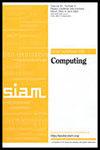不明确的 DNF 和阿隆-萨克斯-塞缪尔
IF 1.6
3区 计算机科学
Q3 COMPUTER SCIENCE, THEORY & METHODS
引用次数: 2
摘要
我们展示了一个明确的-DNF(析取范式)公式,它需要合取范式宽度,这是最优的对数因子。因此,我们得到了图论中Alon-Saks-Seymour问题(1991年提出)的近最优解,该问题的问题是:图的色数与其双曲线分割数之间的差距有多大?我们的结果还暗示了查询/通信复杂性、学习理论和自动机理论中其他几个改进的分离。本文章由计算机程序翻译,如有差异,请以英文原文为准。
Unambiguous DNFs and Alon–Saks–Seymour
We exhibit an unambiguous -DNF (disjunctive normal form) formula that requires conjunctive normal form width , which is optimal up to logarithmic factors. As a consequence, we get a near-optimal solution to the Alon–Saks–Seymour problem in graph theory (posed in 1991), which asks, How large a gap can there be between the chromatic number of a graph and its biclique partition number? Our result is also known to imply several other improved separations in query/communication complexity, learning theory, and automata theory.
求助全文
通过发布文献求助,成功后即可免费获取论文全文。
去求助
来源期刊

SIAM Journal on Computing
工程技术-计算机:理论方法
CiteScore
4.60
自引率
0.00%
发文量
68
审稿时长
6-12 weeks
期刊介绍:
The SIAM Journal on Computing aims to provide coverage of the most significant work going on in the mathematical and formal aspects of computer science and nonnumerical computing. Submissions must be clearly written and make a significant technical contribution. Topics include but are not limited to analysis and design of algorithms, algorithmic game theory, data structures, computational complexity, computational algebra, computational aspects of combinatorics and graph theory, computational biology, computational geometry, computational robotics, the mathematical aspects of programming languages, artificial intelligence, computational learning, databases, information retrieval, cryptography, networks, distributed computing, parallel algorithms, and computer architecture.
 求助内容:
求助内容: 应助结果提醒方式:
应助结果提醒方式:


